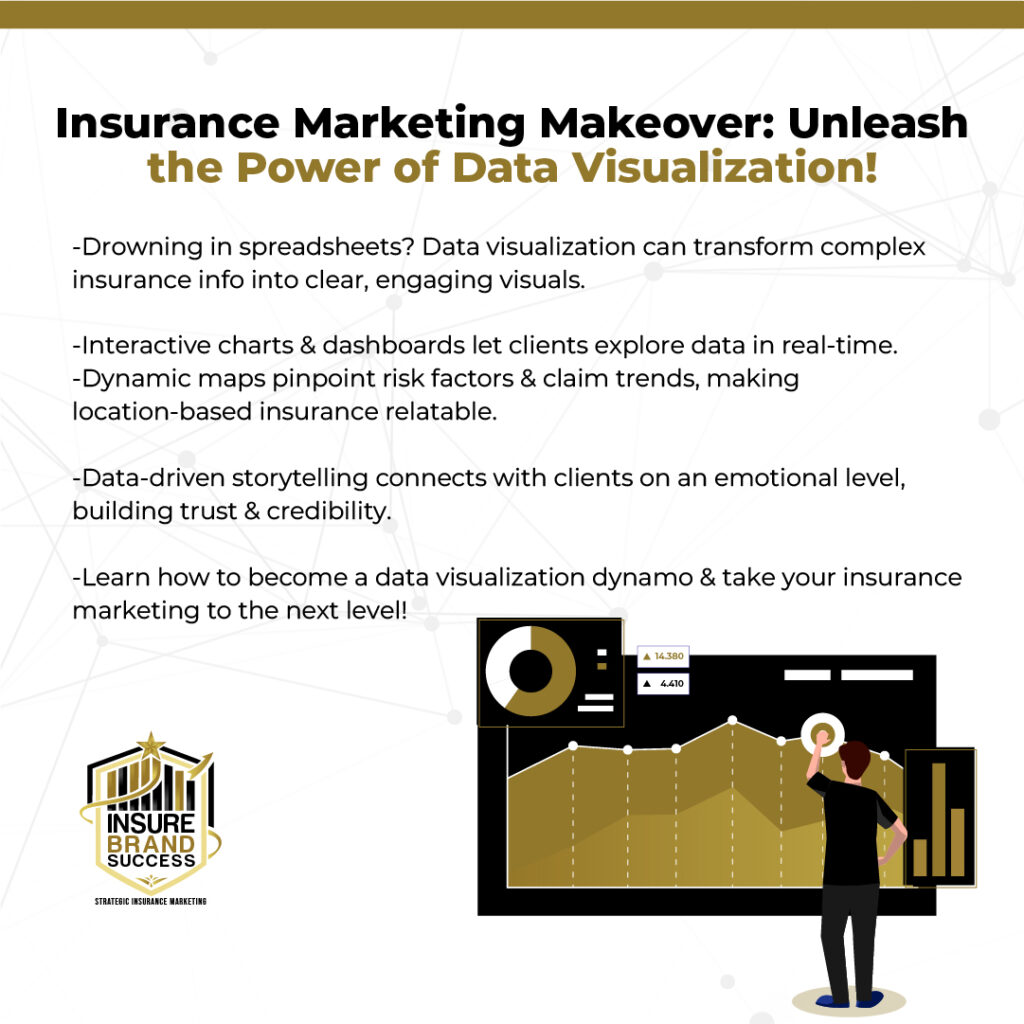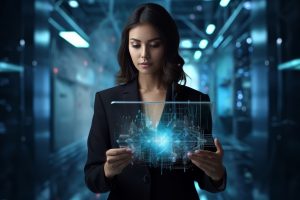In today’s data-driven world, insurance agents and agencies need to stay ahead by making their messaging clearer and more engaging. In the past, brochures and written content may have sufficed to communicate the value of policies and coverage, but now the audience craves something more dynamic. Interactive charts, dashboards, and data storytelling can take your insurance marketing to a whole new level.
This blog post will guide insurance agency owners, managers, and marketing teams on how to transform raw data into compelling stories using advanced visualization techniques. We’ll explore how insurance professionals can benefit from this strategy to enhance their digital marketing efforts, drive customer engagement, and ultimately boost sales.
Why Data Visualization Matters for Insurance Agencies
Insurance is a field that deals with complex data — from policy comparisons to risk assessments. Presenting this information in a digestible format is crucial for educating your clients and helping them make informed decisions. Here’s why data visualization is essential for your agency:
- Simplifying Complex Information: Insurance concepts like deductibles, premium calculations, and risk factors can be difficult to explain. Data visualization translates these numbers into clear, digestible visuals.
- Building Trust Through Transparency: A well-presented dashboard showing policy features, premium comparisons, or historical claims data can help build trust between your agency and potential clients.
- Enhancing Client Engagement: Clients are more likely to engage with content they can interact with. Interactive elements like clickable charts and real-time dashboards allow them to explore data on their own terms.
- Supporting Informed Decisions: By giving clients the tools to visualize policy benefits and risk coverage, you empower them to make better insurance decisions.
Use advanced data visualizations to complement our Insurance SEO Services and enhance your agency’s digital strategy.

Advanced Data Visualization Techniques for Insurance Agencies
While bar charts and pie graphs are useful, more advanced tools can help your agency stand out from the competition. Here are some key strategies you should implement:
1. Interactive Charts and Dashboards
Imagine providing clients with the ability to adjust variables such as deductible amounts or coverage levels in real time and seeing how their premiums change. Tools like Tableau, Power BI, and Domo allow you to create interactive dashboards that clients can manipulate.
- Scenario Planning: Clients can see how different coverage levels affect their premiums.
- Comparative Analysis: Offer side-by-side policy comparisons with interactive elements that allow users to filter by policy type or premium amount.
- Dynamic Risk Assessment: Show potential clients how different risk factors such as their location, type of home, or vehicle model might impact their insurance rates.
Learn more about creating interactive experiences with Websites for Insurance Agencies.
2. Geolocation Data Visualization
Insurance risks often vary by location, so why not leverage geolocation data to show potential clients how these risks could impact their coverage needs?
- High-Risk Areas: Use heatmaps to show areas with high crime rates or natural disaster risks (e.g., flood zones or hurricane-prone regions). This visual can help emphasize the importance of certain types of coverage, like flood or earthquake insurance.
- Target Market Insights: Geolocation visuals can help identify market areas where specific types of insurance are in higher demand, such as renters’ insurance in urban areas or car insurance in suburban neighborhoods.
For more insight into understanding risk by region, check out the FEMA Flood Map Service Center.
3. Data Storytelling for Emotional Connection
Clients don’t just buy insurance for coverage; they buy peace of mind. Data storytelling allows you to present the data behind your insurance products in a way that resonates emotionally with your audience.
- Frame Your Data Around Client Pain Points: For instance, use a client story about a recent claim to show how certain coverages can protect them from similar financial risks.
- Highlight Real-World Benefits: Instead of showing just raw numbers, emphasize how certain policy features translate into tangible benefits for the client.
- Visualize Success Stories: Create case studies or customer success stories using data visualizations. For example, you could show a family’s savings over time after switching to your agency for home and auto insurance.
Find more strategies for impactful communication with our Insurance Email Marketing services.
Tools for Creating Data Visualizations in the Insurance Industry
Not all data visualization tools are created equal, and some are particularly well-suited for the insurance industry. Here are a few platforms to consider:
- Tableau: A versatile tool for creating interactive charts and dashboards. It’s easy to use and integrates well with large datasets, allowing for real-time scenario planning.
- Power BI: Microsoft’s Power BI is another great option, offering strong data visualization capabilities and easy integration with Excel, a program many insurance agencies already use.
- Trovata: This platform is particularly useful for property and casualty insurance, providing templates tailored to insurance data needs.
- Everest: Designed for the insurance industry, Everest offers a range of templates for visualizing key metrics like claims data and underwriting performance.
For inspiration on best practices for data storytelling, check out Harvard Business Review’s Guide to Data Visualization.
How to Tailor Your Data Visualizations for Insurance Clients
Effective data visualization goes beyond simply creating charts and graphs. To fully optimize the impact of your visuals, tailor them to the needs of your insurance clients:
- Focus on Simplicity: Avoid overloading your visuals with too much information. A complex chart filled with excessive details can overwhelm clients and reduce clarity. Stick to the essentials and ensure that your charts highlight the most important insights.
- Use Color Wisely: Colors can evoke emotions and create a sense of urgency or reassurance. For example, red might signal risk, while green suggests safety. Use colors to draw attention to key data points without overwhelming the visual.
- Incorporate Interactivity: Give your clients control over their data exploration. An interactive dashboard that allows users to adjust parameters like deductible levels or coverage terms will keep them engaged and help them see the value in your offerings.
- Add Context: Numbers by themselves don’t tell a story. Always add context to your data visualization. Explain what the data means in practical terms for the client and use real-world scenarios to bring it to life.
If you’re looking to improve client interactions through digital platforms, consider our AdWords for Insurance Agencies services to drive targeted traffic.
Tracking the Success of Your Data Visualizations
Once you’ve implemented data visualizations in your marketing materials, it’s important to measure their effectiveness. Here’s how you can track success:
- Engagement Metrics: Use heatmaps to see where clients are spending time on your interactive dashboards and how often they engage with different elements.
- Lead Generation: Track how many leads are generated from your interactive presentations. Are more people requesting quotes after interacting with your data?
- Customer Feedback: After client meetings or virtual consultations, ask for feedback on the data visualizations. Are they making the information clearer? Did they find it engaging?
External Resource: For best practices on tracking lead generation and engagement, see Google Analytics’ official guide.
Elevating Your Insurance Marketing with Data Visualization
Insurance agencies can no longer rely on static content to communicate complex insurance products and services effectively. By embracing advanced data visualization techniques, such as interactive dashboards, geolocation mapping, and data storytelling, you can present your clients with clear, engaging, and informative insights that will enhance their experience with your agency.
Looking for more ways to transform your insurance marketing? At InsureBrandSuccess, we help insurance agencies refine their digital strategy with cutting-edge tools like data visualization, SEO, and personalized marketing solutions.




